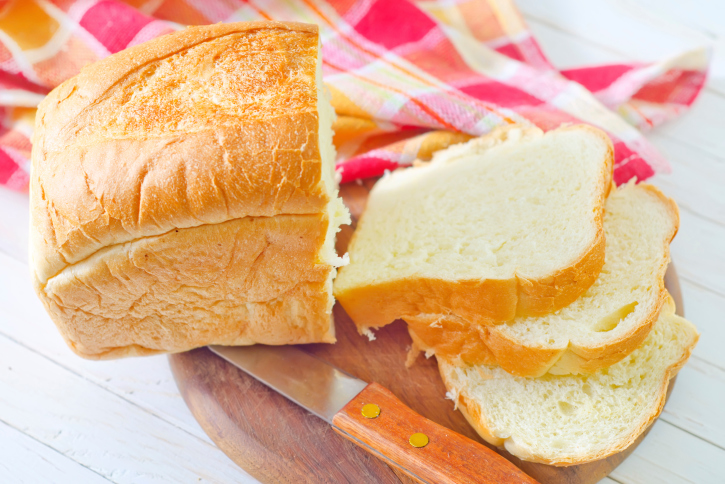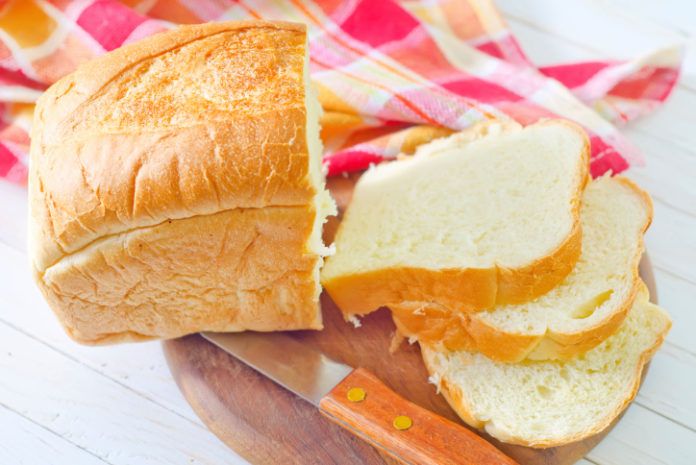From bread to soups, pasta dishes to poultry, the answers might surprise you.Heres how to shake your hidden salt.
In a surprising new study of the sources of sodium in the American diet, the Centers for Disease Control and Prevention (CDC) says the number-one contributor is bread-adding nearly twice the sodium to average consumption as chips and other salty snacks (which rank 10th). Its not so much that bread is high in salt-though the report noted that buying the right type and brand can cut sodium from 230 to 80 milligrams (mg) a serving-as that we eat so much of it. Other food types, in descending order of sodium contribution, in the CDCs top 10 were: cold cuts and cured meats, pizza, poultry, soups, sandwiches and burgers, cheese, pasta dishes, meat mixed dishes (like meat loaf with tomato sauce), and savory snacks.

Together, those 10 food groups account for 44% of the sodium in the typical US diet, according to the CDCs Mary Cogswell, DrPH, and colleagues. Overall, 65% of our average daily sodium consumption of 3,266 mg (which doesnt count salt added at the table or in cooking) comes from foods bought at supermarkets and grocery stores, with another one-quarter consumed at restaurants.
Alice H. Lichtenstein, DSc, director of Tufts HNRCA Cardiovascular Nutrition Laboratory, cautions that each persons sodium sources may vary. What is really important on an individual level is what are your major sources of sodium and how to develop a strategy to reduce your intake, she says. Although for most people bread is the major contributor, for others it may be salty snacks, eating foods prepared outside the home or salt added during cooking. In those cases there are many options to reduce intake, such as shifting to different types of snacks, preparing more foods at home or gradually cutting down on added salt when preparing food.
The CDC team analyzed data from the What We Eat in America portion of the 2007-2008 National Health and Nutrition Examination Survey (NHANES), data on 7,227 Americans ages two and up. In most categories, more than 70% of the sodium consumed came from foods bought at a store. (More than half the sodium consumed in pizza, however, came from foods obtained at fast food or pizza restaurants.) In general, foods from restaurants contained more sodium per calorie than the same category of food bought at a supermarket or other store.
More than 75% of the sodium that Americans consume is added to foods before they ever reach our kitchen or to foods purchased in restaurants and fast food outlets, according to the CDC. Its estimated that only about 5% to 6% of the sodium total is added at home during cooking, with a similar share added at the table.
The average daily sodium consumption of nearly 3,300 mg was almost 1,000 mg more than the maximum recommended by the 2010 Dietary Guidelines for Americans. Its more than double the 1,500 mg daily that the Guidelines advise for all African-Americans and people older than 50, as well as those with hypertension, diabetes and chronic kidney disease-some 57% of the US adult population.
Average sodium consumption is too high, Cogswell and colleagues concluded, reinforcing the importance of implementing strategies to reduce US sodium intake. Such strategies include sodium-reduction efforts by food manufacturers and restaurant chains, they noted, as well as government programs in institutional settings including schools.
But you dont have to wait for those strategies to make a difference before taking a whack at your own sodium intake. You can start by preparing more meals at home, from less-processed ingredients where you have greater control over hidden salt. At the grocery store and in restaurants, you can be a sodium-savvy shopper-starting with those top 10 sources identified by the CDC.
1 Bread and rolls. Probably the most startling finding of the CDC analysis was that 7.4% of the sodium in the typical US diet comes not from salty snacks or other obvious sources but from bread and rolls. While bread is only modestly high in sodium per slice, were a nation of bread lovers and it all adds up.
Bakers dont add salt merely for taste; its important to the baking process and the texture of the finished bread. Salt helps regulate the yeast so the dough doesnt rise too fast, and strengthens the gluten bonds that hold the dough together. That being said, however, the amount of sodium in bread varies widely-in part because of different recipes, partly just because slice sizes differ. Slimmer, low-calorie breads are often also lower in sodium: Sara Lees Delightful bread, for instance, has just 45 calories and 85 mg of sodium per slice.
Nothing beats checking the label-and pay close attention to whether the serving size is one or two slices. Dont assume that just because a bread sounds healthy that its necessarily low in sodium: Roman Meal 100% Whole Wheat, for example, has 200 mg per slice. Nor does natural mean lower sodium.
2 Cold cuts and cured meats. Its not so surprising that these meats should contribute 5.1% of the nations sodium intake-curing, after all, uses salt. Reduced-sodium choices can shave about 25% off regular cold cuts amounts; theres even a lower-sodium Spam, though it still packs 265 mg in 28 grams. Most store-bought cold cuts contain 200-some mg of sodium in a single slice, from 289 mg in ham to 218 even in similarly sized low-salt sliced turkey.
Cook and slice it yourself, however, and you can get turkey as low as 14 mg of sodium per 28-gram slice. (Use the savings from not buying all that packaged food to invest in a food slicer.)
A single slice of bacon contains about 180 mg of sodium; if you cant get along without that bacon-y taste, consider reduced-sodium bacon, at 82 mg a slice. Or try meatless bacon, which has only about 73 mg per slice and is lower in saturated fat.
3 Pizza (4.9%). How could pizza be the third leading contributor of sodium to the US diet? Consider the ingredients, almost all high in salt: cheese (just one cup of shredded mozzarella has 702 mg of sodium), pepperoni and other processed meats (33 mg of sodium in every slice of pepperoni), sauce (233 mg in a half-cup), and even the crust (a 12-inch crust might contain 270 mg). No wonder a regular 14-inch pizza can easily top 6,000 mg of sodium.
Other than simply eating fewer slices, its tough to slash the sodium from restaurant or store-bought pizza. If you make it yourself, however, you can control the quantity of salty ingredients you pile on: Pick reduced-sodium cheese, go easy on the sauce (or opt for fresh tomato slices instead) and top your pie with veggies instead of pepperoni and sausage.
4 Fresh and processed poultry (4.5%). Heres another head-scratcher-salty chicken? But it makes sense when you realize the CDC report found that 27% of the sodium in this category came from fast food, such as chicken nuggets, sandwiches and fried chicken. A six-pack of nuggets has 540 mg of sodium, a chicken club sandwich might top 1,000 mg despite its healthy-sounding name, and one fried chicken breast contributes 1,050 mg.
Home cooking is your best defense here, too-though be wary of enhanced poultry (as well as beef and pork) plumped up with a salt solution, which can bring the sodium in a four-ounce boneless, skinless chicken breast as high as 330 mg. When you do eat out, keep in mind that breading and sauces add sodium to poultry picks.
5 Soups (4.3%). Cooking your own soups is easy and saves you money as well as sodium. Even reduced sodium and healthy canned varieties contain more salt than youd likely add in your kitchen: The low-salt condensed tomato soup, for example, still has 410 mg per serving (versus 480 mg for the standard soup).
6 Sandwiches and burgers (4.0%). One Big Mac has 1,040 mg of sodium, and thats before youve gobbled a single fry. But even healthy-sounding sandwiches can pack plenty of sodium- see poultry, #4 above. Fixing it yourself can minimize the sodium, as long as you go easy on the cold cuts (#2) and cheese (#7). When you do eat out, think small and skip the cheese: A regular McDonalds hamburger, though still not exactly health food, has 520 mg of sodium, less than any other sandwich on the menu.
7 Cheese (3.8%). Just 3.8% of the nations sodium intake doesnt sound so bad, until you consider that cheese is typically just an ingredient, not even an entre. Choosing the right cheese, however, can lower the sodium impact. The sodium in an ounce of cheese can range from 54 mg in Swiss (or as little as 4 mg in reduced-sodium Swiss) to 454 mg in Parmesan. Other popular cheeses fall in-between: Monterey jack (152 mg), colby (171 mg), cheddar (176 mg), fontina (227 mg), gouda (232 mg), provolone (246 mg), feta (316 mg), bleu (395 mg).
8 Pasta mixed dishes (3.3%). Dishes like spaghetti with meat sauce might not seem salty, but the sodium can add up-especially in restaurant or packaged meals. That frozen spaghetti entre could easily top 600 mg per serving, while Olive Gardens Lasagna Rollata al Forno has more than a days worth of sodium at 2,510 mg. Again, making it yourself keeps you in control. Even if you use marinara sauce from a jar, smart shopping can cut the sodium from a typical 540 mg per half-cup: Amys Light in Sodium brand has just 290 mg of sodium, while McCutcheons has a mere 185 mg. Eating out? The lowest-sodium classic pasta dinner at Olive Garden is Linguine alla Marinara, 900 mg.
9 Meat mixed dishes (3.2%). Maybe your moms meatloaf wasnt packed with sodium, but the regular meatloaf at Boston Market has 1,090 mg. Whether you buy your chicken pot pie in the freezer case (968 mg in Marie Callenders brand) or at Boston Market (1,120 mg), youre getting about two-thirds of the sodium most of us should consume in a whole day. Cooking smart from scratch cuts the sodium way down: Our Meatloaf Makeover recipe in the January 2008 newsletter, for example, contains just 320 mg of sodium per serving.
10 Savory snacks (3.1%). Chips, crackers and pretzels are where youd expect Americans sodium to come from, yet they wind up at #10. You can still wreck all your best sodium- reducing efforts with a potato-chip binge (1,348 mg in an eight-ounce bag). And when you read about the health benefits of nuts in this issues Special Supplement, keep in mind that salted nuts can quickly negate the positives of those antioxidants and other nutrients. (Snack lovers can take hope, however, from a recent study that concluded eliminating unperceived salt could slash the sodium in snacks.)
Still, its helpful to remember that snacks arent the only source of sodium (though they still might be your weakness). That way you wont be patting yourself on the back for resisting those cheese crackers (272 mg in a single-serving bag) while whipping up a grilled cheese sandwich and tomato soup for lunch (more than 1,300 mg if youre not careful).
However your sodium sources stack up to the national average, Tufts Lichtenstein says reducing your consumption doesnt have to be daunting. There are so many reduced-sodium foods now available that due to new technology dont really taste that much different than the original products, she adds. It is easier to lower your intake than ever before.
TO LEARN MORE: MMWR Vital Signs, Feb. 7, 2012, www.cdc.gov/mmwr/preview/mmwrhtml/mm61e0207a1.htm.





















